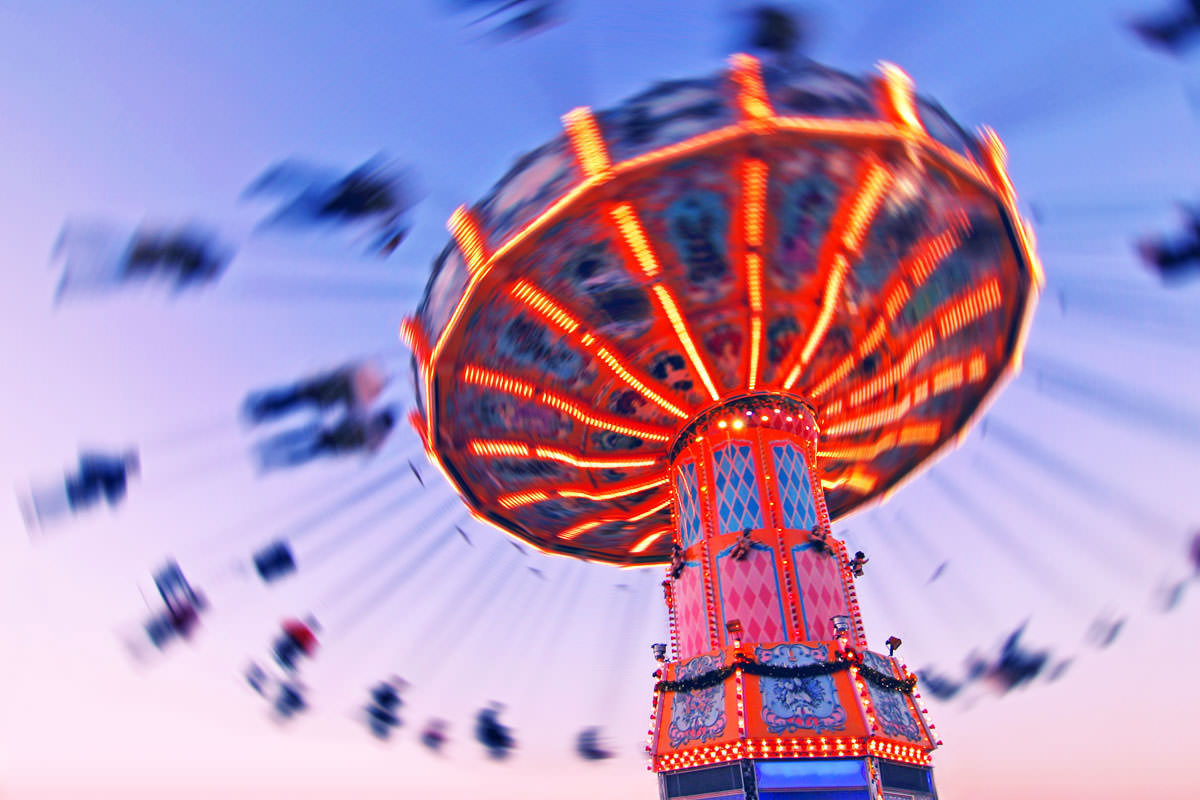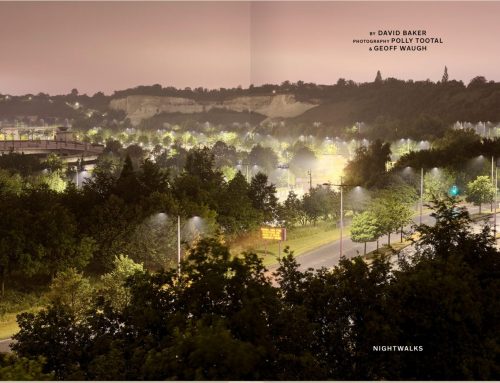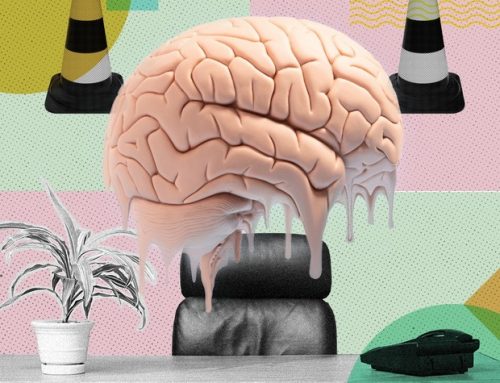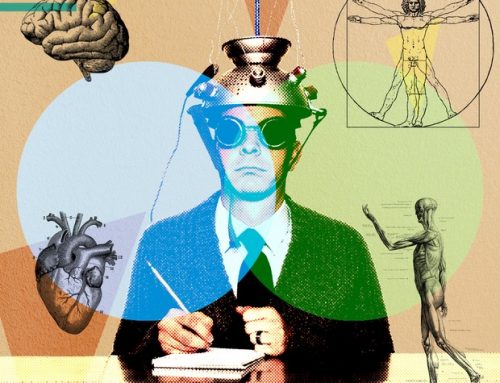The science of theme parks: forget end-of-the-pier distractions, the modern amusement ride is a hi-tech thrill laboratory
Hot Air, September 2001
Eddie Newquist knows a lot about theme parks. As president of film and production at BBH, a firm of park and exhibit designers based in San Antonio, Texas, it’s his job to be up to speed on every single innovation in the sector. He has worked with some of the world’s biggest entertainment “franchises”, from Terminator to Jurassic Park; he has produced films designed to be seen in three dimensions or through 360 degrees; he is, in the words of his company’s corporate website, “an industry innovator, holding patents for developing advanced motion picture/show systems and for designing high-capacity entertainment experiences”. He is, in short, devoted to pushing theme parks to ever more ambitious extremes – to making their attractions ever faster, bigger, better and more sophisticated. But even he knows that, however much technology he may have to show off with, there is one line that should never be crossed. “Some of the new rides on show at the IAAPA [the industry’s trade body, the International Association of Amusement Parks and Attractions] convention last year were not successful,” he recalls. “They just made people sick. If someone comes off a ride and they’re feeling sick then they are not going to want to buy things. And you certainly don’t want that.”
You certainly don’t: organised fun is big business and last year, theme parks in the US took $9.6bn from 317m happy punters. In the EU, theme park turnover topped $1.5m and Alton Towers, the UK’s most popular theme park, welcomed 2.45m people through its gates. Tokyo Disneyland, the best attended theme park in the world, entertained an even more impressive 16m visitors. But what exactly is it that draws people to shoot down an artificial river while being splashed by fake white water, queue for more than an hour to be dropped 200ft in a cage, or clamber into crude body harnesses to be hurled towards rocks at 90mph?
“Theme parks offer two distinct attractions,” explains Glenn Wilson, a psychologist at the Institute of Psychiatry in London, who has made a speciality of researching the industry. “Firstly, they provide a fantasy world, an opportunity for children to lose themselves and for adults to return to childhood; and secondly they give you the chance to rise to the challenge presented by the thrill rides.”
The idea of a “fantasy world” was the first defining feature of the theme park. Back in the early 50s, Walt Disney’s brief to the designers who were to build Disneyland in California was simple: “I just want it to look like nothing else in the world. And it should be surrounded by a train.” Disneyland’s Main Street, two rows of impossibly pristine Victorian shops, businesses, bars and restaurants (some fake, some real) is built on a 5/8 scale. “This cost more,” said Disney, “but it has turned the street into a toy and the imagination can play more freely with a toy.”
If that toytown aesthetic was the first distinct feature of the theme park, though, these days the most important ingredients are not the theatrical looks, but the thrill rides – the roller-coasters, haunted houses and spinning wheels with names like XLR-8, Spider and Vortex, that make the adrenalin run through the body and pull punters through the gates. “It’s very easy to terrify a person,” says John Wardley, an independent ride designer for the Tussaud’s Group and the man behind such cutting-edge attractions as Nemesis and Oblivion, both at Alton Towers, “but that isn’t always entertainment. I am essentially an entertainer. When you design a ride you have the whole spectrum of emotions to play with – you can make them surprised, amazed, baffled, intrigued, scared – and you do that by giving the ride a story, a rhythm. With a white-knuckle ride, the story might be quite simple, but it is still there: you want to challenge them before they get on – dare you do it? You want to give them an intense and thrilling experience in the middle; and you want them to have a feeling of exhilaration at the end that they have got the better of it and have survived.” The process of putting this ideal into practice is where the science of theme parks really comes to the fore.
Theme park rides can be divided into three broad groups: dark rides, where participants are transported through the interior of a warehouse-like structure and are exposed to projections, animatronics, special effects and, hopefully, adrenalin; iron rides, the free-standing spinning wheels or rocking boats that are a feature of every fair; and roller coasters – the T-Rexes of the theme park world. When it comes to storytelling, the dark rides understandably rule the roost. Thanks to advanced audio-visuals and super-detailed 70mm film, parabolic screens as high as houses and multi-channel sound, you can transport the riders to outer space or the centre of the Earth at the flick of a switch. Your scene can be peopled with animatronics – realistic robots that are programmed to speak and move when triggered by a car’s approach – although some park owners prefer actors because they’re cheaper. Add special effects, such as fog or fire, to help the audience forget where they are, so that, for five minutes or so, they fly like Superman, or at least get to think they’re Indiana Jones.
“Dark rides give you an incredible opportunity to make people feel like heroes,” says dark ride scriptwriter Tim Beedle, “because no other medium lets you have the audience playing such an active role.” Beedle works for JPI Design in Ontario, California, a park and ride design company that has just begun work on Adventure World, a $40m theme park just outside of Jeddah, Saudi Arabia. “Writing for dark rides is like writing for theatre or the movies. You map things out scene by scene but the extra dimension is that the audience can be characters in the story too. They are no longer just passive viewers.”
Adventure World is a conversion project – there is a small theme park already on the site which JPI is to expand and improve upon. There is an existing dark ride, a kind of runaway-train-in-a-mine attraction, and one of JPI’s briefs is to recast it as something more interesting. “What we are doing,” says Beedle, “is taking that attraction and changing the story. We have a specific layout to the ride that can’t change – except that we can alter the speed of the train. We came up with a King Solomon’s Mines/Indiana Jones theme, which is fairly new to Middle Eastern audiences. The mine will become an archeological dig where an ancient burial chamber has just been uncovered. The audience becomes visiting scientists invited to view the discovery.” This is the backstory – the explanation of what has happened and why the audience is there before the ride begins. “The backstory does not need to be totally apparent to the audience,” says Beedle, “but it provides a guide for everyone working on the project. In this instance we produced a phoney 1914 newspaper article about an archeological dig in the Kalahari Desert where the burial site of an ancient African king had been discovered. We have also created a main character, Lawrence Chance, a dashing Oxford-educated archeologist, who first came across the tomb.
“The next step is to write the story that the audience will actually experience. You look at the physical properties of the ride and work out how you can involve the audience at each stage. Here they are scientists being taken on a tour of the site by Dr Chance. They find this out when they are waiting in the pre-show area. There are lots of mining tools scattered around, clippings from scientific journals and so on. Just before boarding the train, Dr Chance comes on the PA and welcomes the scientists to the site, advises them that the tour is about to commence and, almost as an afterthought, warns them that tomb robbers have been seen in the area.”
Beedle says the trick is to have a clear beginning, middle and end. That way the audience gets a story but also knows where they are. In the case of King Solomon’s Mines (the ride does not have an actual name yet), the first few rooms are “people digging and Dr Chance on the PA telling you where you are”. Then, after a couple of minutes, “all hell breaks loose. Dr Chance tells you that the tomb raiders are trying to hijack the train and they are going to take you off and shoot you. This is the advantage of having the audience involved from the start – they really feel they are in danger. The ride turns from a tour into an escape ride and Dr Chance turns from our rather dry guide to the hero who is going to get them out of there. This is obviously a good time to speed up the train.”
The train is now rattling from scene to scene as the riders and Dr Chance (via animatronics and a voiceover) fight the tomb robbers. Each of them is killed (of course) but, as a bonus, by killing the last one, the riders accidentally open up the king’s long-lost central burial chamber. “The audience has achieved what even Dr Chance couldn’t,” says Beedle. “They are the heroes now and the scene rewards them with waterfalls, gold, effects and, above all, congratulations.”
“You’ve gone from zero to hero in the space of one ride – and within five to six minutes, if the theme park owner is going to get any return from their investment. “You can get a lot in that time,” says Beedle, “but you don’t want to make it too complex. You don’t want important dialogue being drowned out by the screams for instance or people won’t know what is going on.” Technical effects also have to be able to reset themselves by the time the next car comes along.
People usually use dark rides to take a break from the high(er)-adrenalin attractions in a park, but it is the thrill rides themselves which are the real people magnets and there are two ways in which they can tell stories of their own.
The first is all about logistics: where the ride is positioned, the dynamics of the queue, what the audience can see and what is kept hidden from view are all factors that help create the ride’s drama and maximise the audience’s enjoyment of the experience. “You don’t ever want to position your roller coaster at the very front of your park,” advises Newquist. “You need to pull people through the park towards your most popular experience, leading them deeper and deeper into the park and past all the Coke stands and merchandise stores.”
Because roller coasters are so big, they can usually been seen from anywhere in the park. And even if you can’t see one, you can still hear the riders’ screams. “The sight of the coaster and the sound of the riders attract people towards it,” says Newquist. “So they are already excited by the time they get there. Then when they are in the queue you want to slowly increase their heartbeat, make them sweat a little. The queue is designed so that the track goes right over their heads and they can hear the rattling and screams as the cars go past. This sends their anticipation through the roof until finally, by the time they get on the ride, they are going crazy. Then, because many roller coasters are gravity-powered, that initial slow, uphill drag is perfect for stoking their anticipation to the max.”
The second way thrill rides affect you is through physical sensations alone. Unlike dark rides, thrill rides offer much less chance for audience participation – it’s hard to do much on a roller coaster other than stick your arms above your head and scream. But roller coasters do ensure maximum audience involvement because of the way they throw people in different directions – it is the difference between sitting and watching a boxing match and actually taking part in one. Thrill rides communicate with their audiences not through audio-visuals and animatronics but through G-forces. And understanding that requires a brief lesson in physics.
A G-force is a unit of acceleration (any change in speed and/or direction). The greater the change the greater the G-force that is applied to the body – something you can feel when you corner in a car. The tighter the bend or the faster you are driving, the more you feel the G-forces pushing into you.
G-forces alter a person’s weight. Sitting in an armchair, an individual experiences a G-force of one, exerted by the pull of gravity. Bundle the person and the chair into a high-speed lift and push the button for the top floor and the G-force they experience will increase as the lift accelerates upwards. A G-force of two doubles your weight, three triples it and so on. On the other hand, if G-forces decrease until they are almost zero a person can become almost weightless as a result of all the strange sensations that accompany such a state. Managing these G-forces is what thrill ride design is all about, because changes in them (and the consequent changes in a person’s weight) can produce a lightness in the stomach and a feeling of euphoria as the internal organs and blood are moved around inside the body. High-thrill rides can vary G-forces between zero and about five (for a useful comparison, consider that taking off in a civil aircraft applies about 1.5G to the body, taking off in a fighter plane about nine). Swinging between these extremes is what attracts people to these rides – one fan of Alton Towers’ Nemesis ride described the sensation of “your blood pooling in your feet” and he meant it as a good thing.
Given the doll’s house sensibility of Disney’s original concept, it’s perhaps fitting that the three fundamental components of thrill rides can be found in any children’s playground: the swings, the roundabout and the slide.
A swing is the perfect G-force machine. As a person rises up into the air, the speed of the swing slows, reducing the G-force they are exposed to and thereby reducing their weight. At the very top of the arc, the G-force is almost zero, which is what gives you that feeling you could fly away. On the way down, the swing speeds up until, at the very bottom, G-forces get as high as 2G, doubling a person’s weight. (Which is why it is hard for the playground bully to push someone off a moving swing.)
Roundabouts, and their theme park equivalents, apply the same forces as driving round a tight bend in a car. Increase the speed or tighten the curve and you increase the G-force. As children soon discover, turning in a perfect circle at a constant speed is not that exciting, which is why many theme park rides spin faster as they go on or lift up into the air, so that the G-forces differ all around the circle.
Kids love steep slides. The G-forces involved in falling are incredibly small, producing butterflies in the stomach. This is the principle behind roller coasters, of course, but also behind theme park “drop” rides, where a cage is allowed to freefall vertically before being slowed nearer the ground. Drop rides produce a G-force of zero – literal weightlessness – on the way down, followed by an intense G-force “kick” at the bottom. (Water rides are slides with lubrication. Water decreases friction by almost 98 per cent, which means you don’t have to build anywhere near as steeply to achieve high speeds. A “flume” ride at an angle of just 6 degrees can give you speeds of 20mph.)
Front or back? For all the high-thinking involved in the construction of the modern roller coaster ride, this simple question remains one of the most important of all. G-forces behave differently at the front and back of a roller coaster train and aficionados are split as to which is better (only wimps sit in the middle). At the front, riders feel the greatest G-forces as they come out of a bend or a dip. Those at the back feel the biggest “kick” as they go over a crest, because the cars in front of them are already starting to accelerate down the next slope. Many roller coasters are designed so that they produce negative G-forces as the cars go over each crest – which means that if they weren’t strapped in, the riders would float upwards like astronauts.
Unsurprisingly, many designers agree that rides have reached the limits of what the human body can take. “Around three or four G is as far as you want to go for any while,” says Wardley, the man behind Alton Towers’ Nemesis and Oblivion rides,“more than that is uncomfortable.” Their response has been to move away from what rides can do to the body towards what they can do to the mind.
Imagine driving along a motorway at 70mph. Now imagine driving at the same speed along a side street. It’s obvious which feels faster and it is that trick of perception that lies behind the thrill of Nemesis. “At Alton Towers you are forbidden to build higher than the tree tops,” says Wardley, “so we take the ride above and below ground. That way you can bring the riders close to rock walls, waterfalls and the edges of the holes themselves. This gives an incredible feeling of speed.”
And of vulnerability. Ask any Nemesis rider what they remember most and it is the feeling that their legs were going to be lopped off below the knee by a dangerously close piece of rock. “I wanted to make them feel very vulnerable,” says Wardley, “so we designed a chairlift that leaves their feet dangling and of course allows them to swing out on the curves.”
As if that weren’t enough, next year Alton Towers opens a new roller coaster called Air, in which even the chairlift is dispensed with. Riders will hang horizontally in harnesses that allow them to fly. That way, it’ll be their heads that are nerve-wrackingly close to that rock.
“A thrill ride,” says Wilson, the psychologist at London’s Institute of Psychiatry, “is like a rehearsal for a real-life disaster. It is one of the few places you are allowed to scream. What makes a good ride so satisfying is the feeling of fear being followed by the pleasure of having survived. The amount of adrenalin in the brain increases, sharpening one’s senses and increasing the heartbeat, to be followed when the fright is over by endorphins that make people feel happy and exhilarated.”
Playing with neurotransmitters is also the principle of good overall park design. Demis Hassabis, designer of the best-selling video game Theme Park, which so accurately simulates the various factors involved in building and running a theme park that it is used in business schools across the world, says that the positioning of rides is as important as the rides themselves.
“You have to keep hitting the visitors with a shot of adrenalin every so often,” says Hassabis, who is now leading his own video game company and hard at work on an elaborate and ambitious PC strategy title called Republic, where you get to manage entire cities. “We found that the best parks always have exciting rides punctuating the tamer rides.” To do this you have to be able to channel visitors along specific paths, with a park’s “rhythm” defined by its layout. All parks have an orientation area (Disney’s Main Street is the archetypal example) after which visitors have a choice of where to go first. Whichever layout a park uses there are some hard and fast rules for what visitors should find along the way. Each area should have at least two rides – a white-knuckle ride for the kids and a tamer one for mum and dad – as well as that all-important “retail opportunity”.
“You need to make sure you have food stands near the exit of each exciting ride,” says Hassabis, talking about the video game, but making a point equally valid to real-world theme parks, “and drinks stands wherever someone is going to be walking a long way. You can also charge more for food and souvenirs near the end of an exciting ride. The more happy people are, the less they are worried about cost.”
Parks in the UK tend to be less concerned about retail sales than those in the US, but across the Atlantic sales of burgers, Coke and “I Survived The Twister” T-shirts are often a mainstay of a park’s income. “You always want to end your attraction with a big wow,” says Newquist. “They have done something terrifically heroic and you can take advantage of that wonderful feeling with the retail experience. There has to be a retail opportunity at the end of every ride.”
In five minutes, you have warped gravity, become a hero, felt the blood pool in your feet and bought the T-shirt. And you thought you were just going along for the rides.






